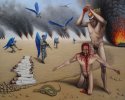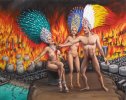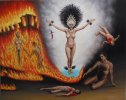Acting Out On Drives
This series of paintings explores the nature of individuals acting on their drives, following impulses often unconsciously motivated in their violence.
The acts I depict in these canvases interpret crimes we are familiar with from mythology, literature and history, acts which reveal the aggressivity tragically inherent at all times in the human condition. As the psychoanalyst J.-B. Pontalis writes (in “Un jour, le crime”): « today’s tabloid news combines personal history, the singular factors that triggered a given event, with something that rises up from the depths of past ages: a transfusion of the archaic into the present. » All my allusions stressing this continuity between classical or biblical narratives and the present involve fire: the fire of wars, of catastrophes, of collective moments that in turn reflect the fire of passion, be it purifying, expiatory or destructive. The scenes represent violence incarnate, whether individual or collective, and exhibit behavioral archetypes in which passions, criminal or otherwise, and a cult of hatred, or rather love-hatred, rage and vengeance, know no bounds.
My actors appear naked or nearly so, personified through attitudes, poses and body accessories that identify them with the timeless world of Carnival. This compendium of crimes and murders (fratricides, parricides, matricides, infanticides, magnicides, etc.) is thus inspired by the theatralicality of popular festivals, and the inner dynamics that often govern participants in crowd situations.
In Christian tradition, Carnival owes its origins to the Latin word carnelevare, a compound of carne (flesh) and levare (remove). Carnival marks the start of Lent; in it, Christianity recovers aspects of ancient cults such as the Roman Lupercalia and Saturnalia and Greece’s Dionysian rites – themselves derived from even more ancient practices requiring human sacrifice, to fertilize harvests, for instance, by sacrificing and quartering a victim and strewing his flesh and blood over the fields.
The Lupercalia ensured the start of the new year, symbolized the incursion of wildness into the civilized world, of disorder into the social order, and of the world of the dead into that of the living – appeasing and exorcising primordial chaos by assimilating it in ritual.
This harking back to earlier cultures and cults was the starting point for our ancient civilizations.
In harsh lighting the naked bodies I depict exult in an impulsive daring (the “passage to an act” psychoanalysts speak of) that is inevitably, unconsciously in thrall to a drive that goads them to excess, to the point of committing deadly deeds. This state of being naked, of a nakedness fraught with sensuality, symbolizes the drive-passion and its unambiguous consequences. In this work, the emphasis on the life and death drives lived out by characters as they take action is resignified in the trappings they wear of a festivity that raises drives to something like the frenzied pitch of Dionysian trance.
![]() See also :
Urban landscapes
,
Landscapes
,
Others
See also :
Urban landscapes
,
Landscapes
,
Others





